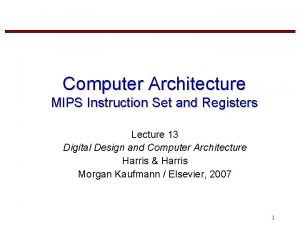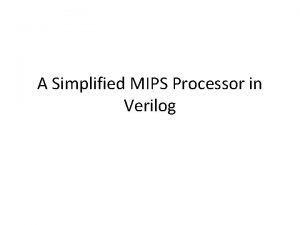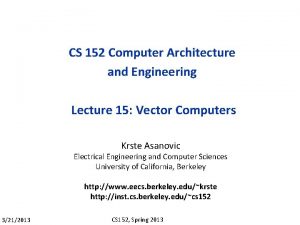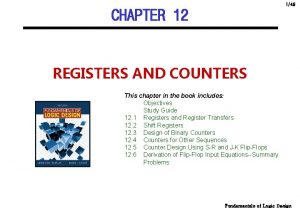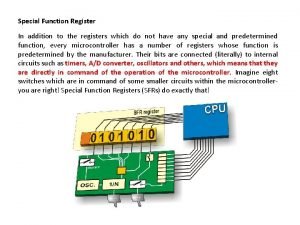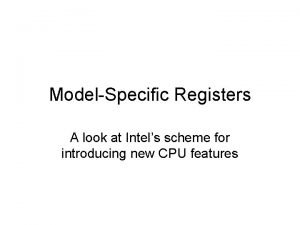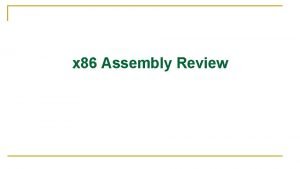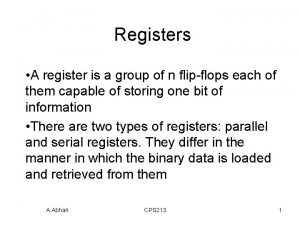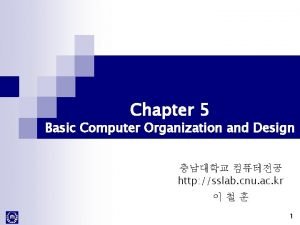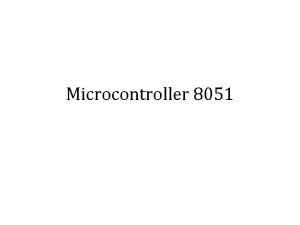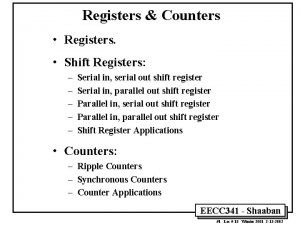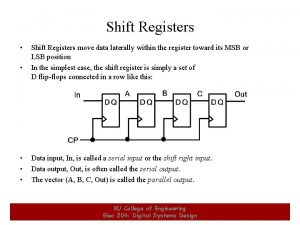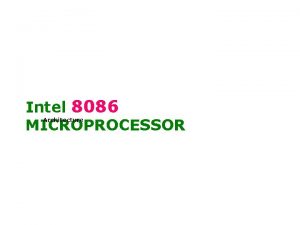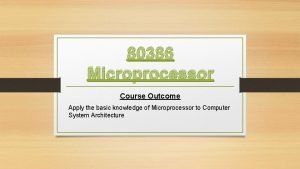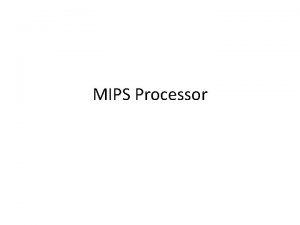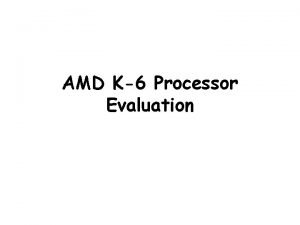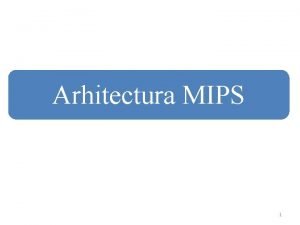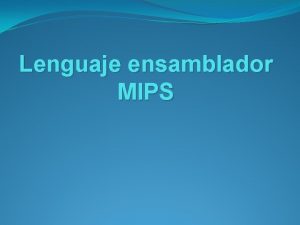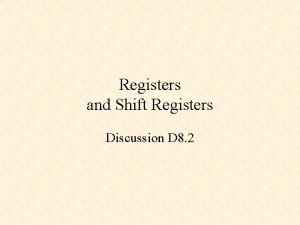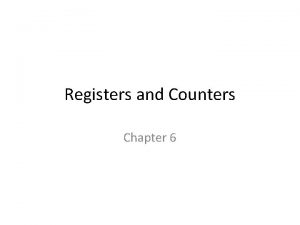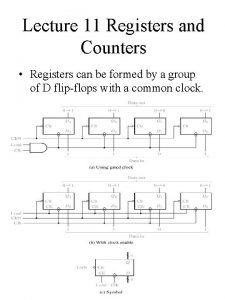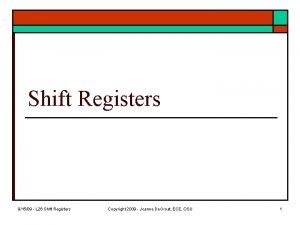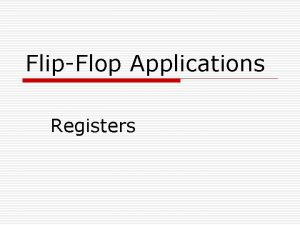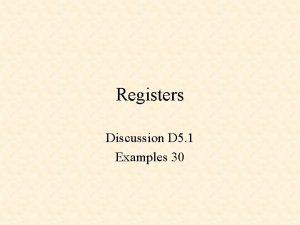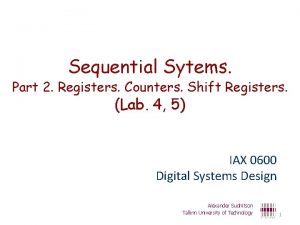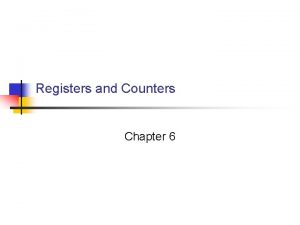MIPS Processor Registers in MIPS In MIPS there


























- Slides: 26

MIPS Processor

Registers in MIPS • In MIPS, there are 32 Registers. • We need read up to two registers, and write to up to one register. • Think registers as D flip-flops. Each register has 32 Dffs. • The control signals are: – read. Reg 1, read. Reg 2: 5 bits. Used to specify which reg to read. – write. Reg: 5 -bits. Used to specify which reg to write. – Data: if write, what data should be written into the reg. – Reg. Write: whether to write or not.

• This is for read.

To write to a register • The data is connected to every register. • Use Reg. Write, generate a ``LOAD’’ signal for the register you want to write to. Ø Every register has a LOAD signal. If that signal is `1’, new data will be set. Ø Only the target register’s LOAD signal is `1’.

RAM

A RAM Example • RAM. Control signals: – address: If write, which location to write to. If read, which location to read from. – Chip select: whether to use this chip or not. – Output enable: whether to enable output (output some voltage or in high-impedence state) – Write enable: whether to read or write. – Din: if write, what data should be written into the location specified by address. 11/8/2007 10: 04: 17 AM • week 11 -5. ppt Assume that there is a RAM with only 2 address lines and two bit data lines. How many bits can it hold? 6

The processor • We now know all the parts in the processor. – ALU – PC – Register file Also – RAM • How to put them together? How to make them execute an instruction as we need?

ALU

The execution of an instruction • First we need to fetch the instruction at the address given by the current PC from instruction memory • Then we need to decode the instruction • Based on the instruction, we need to do accordingly • For sequential instructions, we then go the next instruction by increasing the PC. For jump and branch instructions, PC will be changed

Basic MIPS Implementation • We will focus on design of a basic MIPS processor that includes a subset of the core MIPS instruction set – The arithmetic-logic instructions add, sub, and, or, and slt – The memory-reference instructions load word and store word – The instructions branch equal and jump 11/18/2007 7: 39: 36 PM week 13 -1. ppt 10


MIPS Implementation Overview • For every instruction, the first two steps are identical – Fetch the instruction from the memory according to the value of the program counter – Read one or two registers (using fields of instructions to select the registers) • For load word, we need to read only one register • Most other instructions (except jump) require we read two registers – After the two steps, the actions required depend on the instructions • However, the actions are similar 11/18/2007 7: 39: 36 PM week 13 -1. ppt 12

Instruction Fetch and PC Increment • Since for every instruction, the first step is to fetch the instruction from memory – In addition, for most instructions, the next instruction will be at PC + 4 11/18/2007 7: 39: 38 PM week 13 -1. ppt 13

R-type Instructions • Also called arithmetic-logical instructions – Including add, sub, and, or, and slt – Each one reads from two registers, performs an arithmetic or logical operation on the registers, and then write the result to a register 11/18/2007 7: 39: 38 PM week 13 -1. ppt 14

R-type Instructions • Suppose the instruction is add $t 0, $t 1, $t 2, what are the read reg 1, read reg 2, and write reg? What is the value of Reg. Write? How to control the ALU to do add? 11/15/2007 5: 02: 08 PM week-13 -3. ppt 15

Datapath only for R-type instructions

Datapath only for R-type instructions (Answer)

Data Transfer Instructions • Load word and store word instructions have the following general form – lw $rt, offset_value($rs) • opcode (6 bits) rs (5 bits) rt (5 bits) offset (16 bits) – sw $rt, offset_value($rs) • opcode (6 bits) rs (5 bits) rt (5 bits) offset (16 bits) – They need to compute a memory address by adding the base register to the sign-extended 16 bit offset 11/15/2007 5: 02: 10 PM week-13 -3. ppt 18

Load • For instruction load $t 0, 16($t 1), what should the control signal be?

Data path

Data path only for lw (answer)

Data path only for sw (answer)

Branch Instruction • Beq has three operands, two registers that are compared for equality and a 16 -bit offset used to compute the branch-target address – beq $rs, $rt, offset • opcode (6 bits) rs (5 bits) rt (5 bits) offset (16 bits) – Note that the 16 -bit offset is given in terms of instructions, not bytes and is relative to PC + 4 11/18/2007 7: 39: 42 PM week 13 -1. ppt 23

Designing a processor only for beq Are these enough? How many adders do we need? How to do the selection?

Designing a processor only for beq

Designing a processor only for beq (answer) 11/18/2007 7: 39: 43 PM week 13 -1. ppt 26
 Good design demands good compromises
Good design demands good compromises Mips processor
Mips processor Instruction memory mips verilog
Instruction memory mips verilog Flag register in 80386
Flag register in 80386 Vector registers
Vector registers Registers and counters
Registers and counters Register storage
Register storage Computer registers
Computer registers Common bus system for 4 registers
Common bus system for 4 registers Vocal fry
Vocal fry Counters shift registers
Counters shift registers Function of register
Function of register Model specific register
Model specific register General purpose registers in assembly language
General purpose registers in assembly language Registers are groups of
Registers are groups of Design of accumulator logic in computer architecture
Design of accumulator logic in computer architecture Pcon register in 8051
Pcon register in 8051 Counters shift registers
Counters shift registers Hardware address protection with base and limit registers
Hardware address protection with base and limit registers Ax + bx + cx + dx
Ax + bx + cx + dx Counters shift registers
Counters shift registers Nhmis nigeria
Nhmis nigeria Clarinet chalumeau register
Clarinet chalumeau register Bris business registers interconnection system
Bris business registers interconnection system Internal architecture of 8086 microprocessor
Internal architecture of 8086 microprocessor 80386 registers
80386 registers Business registers interconnection system
Business registers interconnection system
